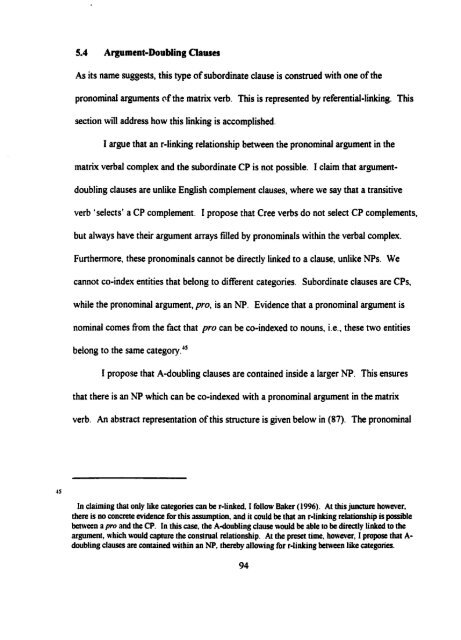Adverbial and Argument-Doubling Clauses in Cree - MSpace
Adverbial and Argument-Doubling Clauses in Cree - MSpace
Adverbial and Argument-Doubling Clauses in Cree - MSpace
You also want an ePaper? Increase the reach of your titles
YUMPU automatically turns print PDFs into web optimized ePapers that Google loves.
5.4 <strong>Argument</strong>-<strong>Doubl<strong>in</strong>g</strong> <strong>Clauses</strong><br />
As its name suggests, this type of subord<strong>in</strong>ate clause is construed with one of the<br />
pronom<strong>in</strong>al arguments cf the matrk verb. This is represented by referential-l<strong>in</strong>kuig. This<br />
section will address how this l<strong>in</strong>k<strong>in</strong>g is accomplished.<br />
I argue that an r-l<strong>in</strong>k<strong>in</strong>g relationship between the pronom<strong>in</strong>al argument <strong>in</strong> the<br />
matrix verbal complex <strong>and</strong> the subord<strong>in</strong>ate CP is not possible. I claim that argumentdoubl<strong>in</strong>g<br />
clauses are unlike English complement clauses, where we Say that a transitive<br />
verb 'selects' a CP complement. I propose that <strong>Cree</strong> verbs do not select CP complements,<br />
but always have their argument arrays filled by pronorn<strong>in</strong>als with<strong>in</strong> the verbal complex.<br />
Furthemore, these pronom<strong>in</strong>als cannot be directly l<strong>in</strong>ked to a clause, unlike NPs. We<br />
cannot co-<strong>in</strong>dex entities that belong to different categones. Subord<strong>in</strong>ate clauses are CPs,<br />
while the pronom<strong>in</strong>al argument, pro, is an NP. Evidence that a pronom<strong>in</strong>al argument is<br />
nom<strong>in</strong>al cornes from the fact that pro can be co-<strong>in</strong>dexed to nouns, i.e., these two entities<br />
belong to the same category."<br />
I propose that A-doubl<strong>in</strong>g clauses are conta<strong>in</strong>ed <strong>in</strong>side a larger NP. This ensures<br />
that there is an NP which can be co-<strong>in</strong>dexed with a pronom<strong>in</strong>al argument <strong>in</strong> the matrix<br />
verb. An abstract representation of this structure is given below <strong>in</strong> (87). The pronom<strong>in</strong>al<br />
In claim<strong>in</strong>g that only like categories can be r-l<strong>in</strong>ked, 1 follow Baker (1996). At this junctwe however,<br />
there is no concrete evidence for this assumption, <strong>and</strong> it could be that an r-l<strong>in</strong>k<strong>in</strong>g relationship is possr'ble<br />
benveen a pro <strong>and</strong> the CP. In this case, the A-doubl<strong>in</strong>g clause would be able to be dircctiy l<strong>in</strong>kcd to the<br />
argument, which would capture the construaI relationship. At the preset time, however, 1 propose that A-<br />
doubl<strong>in</strong>g clauses are conta<strong>in</strong>ed with<strong>in</strong> an NP, thereby allo~<strong>in</strong>g for r-l<strong>in</strong>k<strong>in</strong>g between like categories.








![an unusual bacterial isolate from in partial fulf]lment for the ... - MSpace](https://img.yumpu.com/21942008/1/190x245/an-unusual-bacterial-isolate-from-in-partial-fulflment-for-the-mspace.jpg?quality=85)




![in partial fulfil]ment of the - MSpace - University of Manitoba](https://img.yumpu.com/21941988/1/190x245/in-partial-fulfilment-of-the-mspace-university-of-manitoba.jpg?quality=85)


